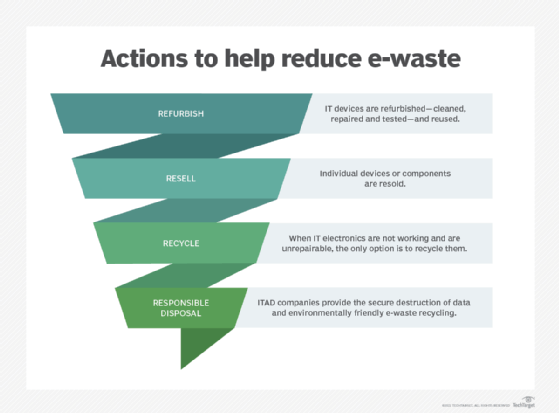What is e-waste?
Electronic waste, or end-of-life (EOL) electronics or e-waste, refers to discarded, recycled or refurbished electrical and electronic products. Correct disposal of e-waste is often included in a company's green computing strategy.
The U.S. Environmental Protection Agency (EPA) divides e-waste into the following 10 distinct categories:
- Large household appliances.
- Small household appliances.
- IT equipment.
- Consumer electronics, such as smartphones, televisions and computers.
- Light fixtures.
- Toys.
- Tools.
- Medical devices.
- Monitoring instruments, such as smoke detectors, thermostats and weight scales.
- Automatic dispensers, such as vending machines.
Common e-waste items
E-waste is the fastest-growing waste stream in the world today, with more than 62 billion kilograms, or 68 million U.S. tons, produced globally in 2022, according to "The Global E-Waste Monitor 2024," published by the United Nations Institute for Training and Research. It is predicted that this amount will increase to 82 billion kg, or roughly 90 million U.S. tons, by 2030. Many of these devices either contain too many harmful materials to allow proper recycling or are discarded without any thought to proper recycling.
According to the same report, small and large home appliances account for approximately 33% of all e-waste. These include microwaves, vacuum cleaners, dishwashers, clothes dryers and electric stoves.
Information and communication technology equipment is the fastest-growing e-waste sector. This includes laptops, smartphones, keyboards, computer mice and microphones.
Company business practices contribute to the e-waste problem. Forced or planned product obsolescence -- designing a product to fail after a certain amount of use or time -- continues into the 21st century because it increases sales, revenue and profitability.
Since its invention, the smartphone has become the most wasted electronic item on the planet. More than 5.3 billion smartphones were thrown away in 2022, according to the International Waste Electrical and Electronic Equipment (WEEE) Forum. The EPA, recognizing the growing problem of consumers routinely throwing out and replacing one- or two-year-old devices, is reviewing how it classifies commodities versus electronic waste./p>
One positive step in dealing with this waste has been California's Responsible Battery Recycling Act of 2022, which requires manufacturers of covered batteries to submit stewardship plans that establish e-waste collection site networks and strategies for outreach and education about e-waste, as well as recycling efficiency targets and data reporting channels. The idea behind the legislation is to make it easy for consumers and companies to get on board with responsible e-waste handling. This law repealed and replaced the Cell Phone Recycling Act of 2004.
Despite the staggering number of phones discarded in 2022, they -- along with other small EEE items such as electric toothbrushes, toasters and cameras -- account for only 8% of all e-waste, according to the WEEE Forum.
Impact of e-waste
China, the U.S. and India contribute around 20 million metric tons of e-waste combined annually, both imported and exported. Part of the problem is poor care in disposal: The United Nations estimates that only 17% of all e-waste is properly collected and recycled.
In fact, improper and unnecessary disposal of e-waste has a growing and quantifiable negative effect on the biosphere, human health, and national and personal security. Proper handling of e-waste is important, but its practice is controversial and can be highly dangerous to humans handling it.
Biosphere health
Many complex electronic devices contain precious metals and elements. Separating and controlling these metals is extremely difficult and often hazardous to the biosphere. Melting down or incinerating electronic devices contributes to the increased presence of lead in landfills globally. Further, the emission of toxic fumes and gases is a leading factor in environmental degradation, climate change, pollution and contaminated water supply.
Human health
Smartphones and computers contain several hazardous elements. Exposure to these toxic materials harms humans and can adversely affect the nervous system, heart, brain, kidneys, liver and reproductive system.
Many of these electronic appliances and devices contain high levels of lead, mercury and cadmium -- all known carcinogens. Waste management workers handle these hazardous materials. Exposure to them has been linked to lung disease, thyroid issues, birth defects, behavioral changes, and cancer in children and young adults.
Liquid-crystal displays and plasma screens containing toxins and carcinogens are among the worst offenders. Improper disposal and overburdened landfills have increased the risk of exposure to smaller communities and their residents.
Security
In addition, the improper disposal and recycling of smartphones and similar devices have created an imposing threat to national and personal security. Smartphones and computers contain sensitive data subject to leaks and data breaches. Many of these devices contain highly classified and sensitive information, yet their easy-to-use nature makes hacking into them simpler.
Completely erasing sensitive data prior to discarding old devices is crucial in mitigating security threats. That's important to remember since 15 million people in the U.S. were victims of identity theft in 2023, according to the report "2024 Identity Fraud Study: Resolving the Shattered Identity Crisis," produced by Javelin Strategy & Research in conjunction with AARP. The Federal Trade Commission Consumer Sentinel Network logged an additional one million-plus identity theft reports in 2023.

Solutions to e-waste disposal
Despite the potential harm to the environment and individuals, recycling these items is an effective way to cut e-waste sharply. The following are proven ways to approach the problem:
- Return EOL to the company of origin. Many businesses that sell electronic items have their own recycling centers. In addition, recycling there often gives the customer the option to trade in the device for a new one at a fraction of the cost.
- Donate old devices to a civic institution. Local schools, governments and universities always need technology. Many of these institutions have specific days, times and locations for electronic donations, increasing device reuse and preventing improper disposal.
- Look for buyback programs. Businesses such as Best Buy, Target and Walmart have implemented programs to buy back old devices. These programs are designed to make discarding old items as painless for the consumer and as environmentally safe as possible.
- Sell outdated technology. Facebook Marketplace, eBay and Craigslist have made selling old items easier. Some buyers bid on old devices for several reasons, whether personal or professional.
- Search for nearby certified recyclers. The Basel Action Network, a nonprofit recycling organization, certifies numerous recyclers across the U.S. These certified recycling centers almost always accept donations and are managed and staffed by industry professionals.
Disadvantages of recycling e-waste
Recycling e-waste is certainly a laudable objective, but it does come with the following serious challenges:
- Cost. Dismantling electronic devices and processing their components is complex and time-consuming, making it costly.
- Health risks. E-waste can contain lead, mercury, cadmium and other harmful substances. Exposure to some of these toxins can have long-term effects, such as respiratory illness, cancer, neurological damage and birth defects.
- Contamination. Toxins can leach into groundwater at sites where e-waste is handled.
- Recovery rates are often very low. Even at the most advanced e-waste processing facilities, recovery of rare earth elements, lithium and other valuable residues can be minimal or even unviable.
- International dumping burdens less developed countries. A great deal of e-waste from developed countries is illegally or unethically exported to less developed countries, externalizing negative environmental impact and passing along health costs.
Best practices for managing e-waste
The following are several positive steps individuals and industries can take to better manage e-waste handling:
- Establish tracking systems. Implement local and extended systems for tracing e-waste from collection to final processing.
- Hold manufacturers accountable. Establish directives and enforce industry standards that make manufacturers responsible for the entire lifecycle of their products.
- Migration to cloud computing. Most enterprises can function more efficiently by moving to cloud environments. Reducing the number of physical devices on-premises required for data storage is a step forward, e-waste-wise.
- Partner with other companies. Work with other companies doing e-waste processing to consolidate operations and create efficiencies.
- Support certified recycling operations. Promote e-waste processing facilities that adhere to health and environmental standards and have trained employees.
- Create and enforce international e-waste standards. Establish regulations prohibiting illegal dumping or export of e-waste; establish environmental standards through legislation.
- Increase public awareness. Educate the public through organizational and industry initiatives about e-waste, device disposal and recycling.
Recycling enterprise devices brings its own challenges, namely safeguarding sensitive data. Learn how to safely secure data and retire devices.





